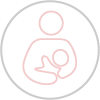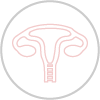The perineum is the region between the vaginal opening and the back passage (the anus). The perineum is susceptible to being injured during delivery of the baby when there is over-stretching, or rapid stretching.
Tears are more common in women in their first childbirth, as the perineum is relatively firm and doesn’t stretch adequately. While an episiotomy (a small surgical cut used to facilitate birth) can prevent major perineal tears to some extent, tears can still occur even after or with an episiotomy. Tears are also common in an inelastic perineum due to the presence of scar tissue from previous vaginal deliveries or other trauma.
Some of the causes of over-stretching of the perineum leading to perineal tear are:
- First vaginal birth or scarring from a previous vaginal delivery
- A large baby compared to size of the mother’s pelvis
- Shoulder dystocia, where the baby’s shoulder gets stuck behind the mother’s pubic bone
- Malpresentation of the baby e.g breech, face presentation, back to back or born with arm/hand adjacent to face
- Forceps delivery or other instrumental deliveries
- Induction of labour
There are classifications of tears, depending on severity, as detailed below….
First Degree Perineal Tear:
Mild laceration or tear of the skin at the edge of the vaginal opening. Major muscles are not affected.
Second Degree Perineal Tear:
A tear from the vaginal opening and rupture of the muscles of the perineum, with some deep tears of the vaginal wall. The tear can extend any distance through the perineum up to the anus, but doesn’t involve the anal sphincter.
– First and second degree tears are sutured in the delivery room under local anaesthetic, and often done by a senior midwife.
Third Degree Perineal Tear:
A tear from the vaginal opening, through the perineum and perineal muscles into the external anal sphincter. Damage to these muscles can be graded according to the depth of injury: 3a, 3b or 3c.
Fourth Degree Tear:
A tear from the vaginal opening, through the vaginal wall and perineal muscles, through the anal sphincters and into the rectal mucosa lining the anal canal, sometimes extending further into the back passage.
– Third and fourth degree tears are often more complex and require suturing under sterile conditions, often in an operating theatre. They are sutured and closed under spinal anaesthetic or epidural, by an experienced doctor only.
(Evidence suggests that approximately 2% of women will sustain this injury during birth).
Symptoms you may have following more severe perineal tears:
- Pain, scarring, sensitivity and soreness
- Weak pelvic floor muscles
- Infection
- Urinary incontinence
- Faecal incontinence
- Problems controlling wind
- Constipation
- Feelings of heaviness or prolapse
- Pain and difficulties with intercourse (physical or psychological)
With the correct management, most women (about 80%) will make a full recovery and have no symptoms one year later. However, many women struggle during this time, and beyond, so timely help and support is essential.
Physiotherapy for Perineal tears:
- Assessment of the scar and healing position of the perineum
- Assessment of the muscle and sphincter function, tone, strength and endurance
- Internal assessment (after 6-8 week GP review and with your consent) to assess pelvic floor muscle function
- Bladder and bowel care
- Advice on diet and lifestyle
- Advice on pain management and therapeutic options
- Scar management: manual therapy (including reducing scar adhesions, soft tissue release, stretching)
- Teaching correct pelvic floor exercises
- Teaching graded exercise program for pelvic floor muscle, abdominals and return to fitness/exercise
- Techniques for improving sexual function



